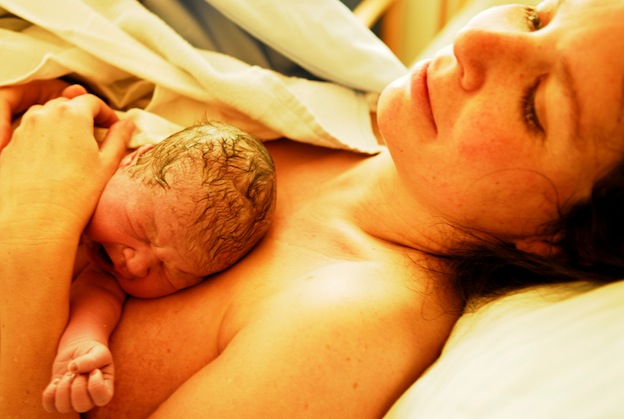SingaporeMotherhood | Baby & Toddler
February 2014
What to Expect: Vaginal Birth After Caesarean (VBAC)

Vaginal Birth After Caesarean or VBAC is the term used to describe the process when a woman gives birth vaginally after having had a previous caesarean delivery. It includes birth assisted by forceps or vacuum.
According to Dr Fong Kah Leng, this is not uncommon. “Three out of four women with a straightforward pregnancy give birth vaginally following one caesarean delivery,” said the obgyn from Sincere Medical Specialist Center for Women.
In her blog VBACsupportsg, copywriter May Tham complies stories of successful VBACs in Singapore and elsewhere. In doing this, the mother of two hopes to help empower other women in their quest for “a more fulfilling birth experience”.
[banner][/banner]
May’s first delivery was a planned caesarean as her baby had IUGR (Intrauterine Growth Restriction). “The C-section was traumatising for me because I had opted for regional anesthesia, which means I was awake during the cutting up and sewing up and could feel the tugging as the placenta was extracted. I believe GA (General Anesthesia) would have been less traumatic. The uncontrollable whole-body ‘shakes’ in the recovery room was very unpleasant as well. That lasted for about half an hour,” May recalled.
Her second delivery on 26 March 2013 was not only normal, it was also drug-free. May practised Hypnobirthing techniques and sought support from a doula. On the day itself, she laboured at home for six hours before going to the hospital. There, she continued to labour on a birth ball, a birthing stool, and in a warm water tub.
“When the time came to push, I didn’t have to. My body did it for me, on auto-pilot. It was like it had taken over from the mind,” May wrote. Her baby was born alert; she was conscious and able to hold him, straight from the womb: “I had waited for this moment for two years. The emotional release was so overwhelming I burst into tears for a good 10 minutes.”
What are the risks of attempting a VBAC?
“Very few doctors out there are comfortable with letting women do this. There is a one per cent risk of uterine rupture due to the surgical cut of the previous caesarean if a woman pushes too hard during the next delivery. If that happens, an emergency C-section is necessary and a supposedly normal baby could come out with severe complications,” May said.
But let’s say all is well, and you are now looking forward to your upcoming VBAC. What should you know?
Will I be safe? “There is a 25 per cent chance you will need to have an emergency caesarean delivery during your labour”. There is also one per cent higher chance of needing a blood transfusion or having an infection in the uterus compared with women who choose a planned caesarean delivery,” said Dr Fong.
Will the c-section scar weaken or rupture? “There is a small risk, about a half per cent that the previous uterine scar may open, causing concerns for you and your baby. Being induced increases the chance of this happening. If there are signs of these complications, your baby will be delivered by emergency caesarean delivery.”
Will my baby be at risk? Not to worry. “The risk of your baby dying or being brain damaged if you undergo VBAC is very small – 0.2 per cent. This is no higher than if you were laboring for the first time, but it is higher than if you have an elective repeat caesarean delivery – which is at 0.1 per cent. However, this has to be balanced against the risks to you if you have a caesarean delivery”.
When is VBAC not advisable?
Dr Fong advises against VBAC for women who have had two or more previous caesarean deliveries, whose uterus had ruptured during a previous labor, and whose pregnancies have complications. There are more technical reasons, too, such as whether the shape of the previous incision would put you at a higher risk for uterine rupture.
In these cases, the obstetrician would probably suggest a planned repeat C-section. This is not without its own benefits. It poses a very small risk of uterine scar rupture, avoids the risks of labour – particularly the risk of possible brain damage or stillbirth from lack of oxygen during labor (which is 0.1 per cent possible), and of course you will know the date of delivery beforehand.
Still, another C-section is not without risks. Mothers will be vulnerable to infection, excessive bleeding leading to a need for a blood transfusion, blood clot formation in the legs and/or lungs, and injury to the bladder, bowel or ureter. For the baby, there may be breathing problems. According to statistics, three to four in 100 babies born by planned caesarean delivery have breathing problems compared with two to three in 100 following a VBAC.
When is VBAC advisable?
“Expecting mothers may want to have a VBAC for the purposes of not having surgery and its risks, to enjoy quicker recovery and therefore a shorter stay in hospital, as well as to have a better chance of an uncomplicated normal birth in future pregnancies. It also reduces the risk of breathing problems for the baby,” said Dr Fong.
However, an obstetrician must assess the condition of a pregnancy before agreeing to a mother’s wish for a normal delivery. A previous successful vaginal delivery, either before or after the C-section, increases the chances of a successful VBAC. And of course, the reason for the previous caesarean section should not be present in the current pregnancy.
Even with the best precautions and under perfect circumstances, reminded Dr Fong, “it is impossible to predict with any certainty which women will achieve a vaginal delivery and which will end up with a repeat caesarean”.
All content from this article, including images, cannot be reproduced without credits or written permission from SingaporeMotherhood.
Follow us on Facebook, Instagram, and Telegram for the latest article and promotion updates.





